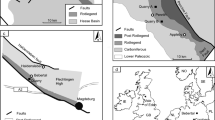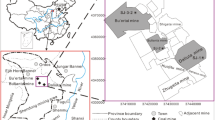Abstract
The study integrated lithofacies analysis and measurement of total organic carbon "TOC," porosity, and mechanical properties to evaluate the main factors controlling rock strength and elastic properties of three carbonate mudrocks units within the Jurassic succession of Central Saudi Arabia. Textural and microstructural analyses revealed that the former two units (Hanifa Formation Hawtah Member and Tuwaiq Formation) have five lithofacies interpreted as a lower shoreface intra-shelf basin deposition, respectively. Two mudrock lithofacies within the Upper Marrat Formation were recognized, both deposited under peritidal low ramp setting. Weak to moderate correlations between mechanical properties and porosity in all studied formations were observed; coefficient of determination R2 values range between 0. 1 and 0.7. Tensile strength has the strongest correlation with porosity and mineral composition. Hard phase mineral (quartz, feldspar, and pyrite) abundance has a more robust correlation with elastic moduli compared to the other minerals. Relatively higher R2 values were observed for the correlations between rock strength and clay + TOC content in Tuwaiq and Hanifa compared with Marrat mudrocks. Marrat and Tuwaiq mudrocks lithofacies have a stronger correlation between particle size and unconfined compressive strength, whereas particle size is weakly correlated with elastic moduli. Sedimentary layering and associated anisotropy significantly control these correlations. Deep lower shoreface deposits of Hanifa mudrock are mechanically stiffer than intra-shelf basin outer ramp deposits of Tuwaiq mudrock lithofacies. Peritidal Upper Marrat mudrock lithofacies have slightly higher stiffness than Tuwaiq mudrock and lower stiffness than Hanifa mudrock. The results are useful to predict the rock brittleness of these Jurassic intervals and their worldwide equivalent.














Similar content being viewed by others
References
Ilgen, A.G.; Heath, J.E.; Akkutlu, I.Y.; Bryndzia, L.T.; Cole, D.R.; Kharaka, Y.K.: Shales at all scales: exploring coupled processes in mudrocks. Earth Sci Rev. 166, 132–152 (2017)
Dewhurst, D.N.; Delle Piane, C.; Esteban, L.; Sarout, J.; Josh, M.; Pervukhina, M.; Clennell, M.B.: Microstructural, geomechanical, and petrophysical characterization of shale caprocks. In: Geol. Carbon Storage, pp. 1–30. Wiley, Hoboken (2019)
Sondergeld, C.H.; Newsham, K.E.; Comisky, J.T.; Rice, M.C.; Rai, C.S.:Petrophysical considerations in evaluating and producing shale gas resources. In: SPE 155756, SPE unconventional gas conference February 23–25, 2010, Pittsburgh, PA (2010)
Rybacki, E.; Reinicke, A.; Meier, T.; Makasi, M.; Dresen, G.: What controls the mechanical properties of shale rocks?—part I: strength and Young’s modulus. J. Pet. Sci. Eng. 135, 702–722 (2015)
Lazar, O.R.; Bohacs, K.M.; Macquaker, J.H.S.; Schieber, J.; Demko, T.M.: Capturing key attributes of fine-grained sedimentary rocks in outcrops, cores, and thin sections: nomenclature and description guidelines. J. Sediment. Res. 85, 230–246 (2015)
Dunham, R.J.: Classification of carbonate rocks according to depositional textures. In: Ham, W.E. (Ed.), Classification of Carbonate Rocks—A Symposium, vol. 1, pp. 108–121. AAPG Memoir (1962)
Hakami, A.; Al-Mubarak, A.; Al-Ramadan, K.; Kurison, C.; Leyva, I.: Characterization of carbonate mudrocks of the Jurassic Tuwaiq Mountain Formation, Jafurah basin, Saudi Arabia: implications for unconventional reservoir potential evaluation. J. Nat. Gas Sci. Eng. 33, 1149–1168 (2016)
Delle Piane, C.; Almqvist, B.S.G.; MacRae, C.M.; Torpy, A.; Mory, A.J.; Dewhurst, D.N.: Texture and diagenesis of Ordovician shale from the Canning Basin, Western Australia: implications for elastic anisotropy and geomechanical properties. Mar. Pet. Geol. 59, 56–71 (2015)
Sone, H.; Zoback, M.D.: Mechanical properties of shale-gas reservoir rocks—part 1: static and dynamic elastic properties and anisotropy. Geophysics 78, 381–392 (2013)
Carrigan, W.J.; Cole, G.A.; Colling, E.L.; Jones, P.J.: Geochemistry of the Upper Jurassic Tuwaiq Mountain and Hanifa Formation petroleum source rocks of eastern Saudi Arabia. In: Katz, B.J. (Ed.) Petroleum Source Rocks, pp. 67–87. Springer, New York (1995)
Bromhead, A.; Sutcliffe, O.; Cousins, T.; Weeks, D.; Davies, R.: Lessons learned from established unconventional resource plays application to emerging plays in the Middle East. In; IPTC-19975-MS, International Petroleum Technology Conference. January 13–15, 2020, Dhahran, Kingdom of Saudi Arabia (2020)
Al Ansari, Y.; Fateh, A.; Shehab, A.: Hanifa-Tuwaiq Mountain Zone: the edge between conventional and unconventional Systems? Search and Discovery Article #80539, 12th Middle East Geosciences Conference and Exhibition. 7–10 March 2016, Manama, Bahrain (2016)
Al-Mojel, A.; Razin, P.; Dera, G.: High-resolution sedimentology and sequence stratigraphy of the Oxfordian-Kimmeridgian, Hanifa, Jubaila, and Arab outcrops along Jabal Tuwaiq, Central Saudi Arabia. J. Afr. Earth Sc. 165, 103803 (2020)
Ziegler, M.A.: Late Permian to Holocene paleofacies evolution of the Arabian Plate and its hydrocarbon occurrences. GeoArabia 6(3), 445–504 (2001)
Fallatah, M.I.; Kerans, C.: Stratigraphic evolution of the late Jurassic Hanifa Formation along the Tuwaiq escarpment, Saudi Arabia: evidence for a carbonate ramp system. Sediment. Geol. 363, 152–180 (2018)
El-Sorogy, A.; Al-Kahtany, K.; Almadani, S.; Tawfik, M.: Depositional architecture and sequence stratigraphy of the Upper Jurassic Hanifa Formation, central Saudi Arabia. J. Afr. Earth Sc. 139, 367–378 (2018)
Farouk, S.; Al-Kahtany, K.; El-Sorogy, A.; Abd El-Motaal, E.: High-frequency cycles and sequence stratigraphy of the lower Jurassic Marrat Formation, central Saudi Arabia. Mar. Pet. Geol. 98, 369–383 (2018)
Hughes, G.W.: Middle to upper Jurassic Saudi Arabian carbonate petroleum reservoirs: biostratigraphy, micropaleontology, and paleoenvironments. Geo-Arabia 9, 79–114 (2004)
Al-Husseini, M.I.; Matthews, R.K.: Tuning late Barremian–Aptian Arabian Plate and global sequences with orbital periods. GeoArabia 4, 199–228 (2010)
Powers, R.W: Lexique stratigraphique international. Volume III, Asie, Fas. 10 b1, Arabia Saoudite, p. 177. National Center of Scientific Research, Paris (1968)
Le Nindre, Y.M.; Manivit, J.; Vaslet, D.: Stratigraphie séquentielle du Jurassique et du Crétacé en Arabie Saoudite. Bull. Soc. Geol. Fr. 6(6), 1025–1034 (1990)
Al-Sharhan, A.S.; Christopher, G.; Kendall, S.T.C.: Precambrian to Jurassic rocks of Arabian Gulf and adjacent areas: their facies, depositional setting, and hydrocarbon habitat. AAPG Bull. 70(8), 977–1002 (1986)
Mazzoli, A.; Favoni, O.: Particle size, size distribution, and morphological evaluation of airborne dust particles of different woods by Scanning Electron Microscopy and image processing program. Powder Technol. 225, 65–71 (2012)
Claesson, J.; Bohloli, B.: Brazilian test: stress field and tensile strength of anisotropic rocks using an analytical solution. Int. J. Rock Mech. Min. Sci. 39, 991–1004 (2002)
Gramin, P.; Fisher, R.; Frooqnia, A.; Ai, A.; Hojnaki, P.; Louis, L.; Hampton, J.: Evaluation of the impulse hammer technique for core mechanical properties profiling. In: Paper SCA045, SCA 30th International Symposium. August 21–26, 2016, Snomass, Colorado (2016)
Martin, R.; Louis, L.; Boitnott, G.: Core analysis workflow for evaluating geomechanical heterogeneity and anisotropy in an Oligocene shale from the Gulf of Mexico. In: 51st US Rock Mechanics/Geomechanics Symposium. June 25–28, 2017, San Francisco, California, USA (2017)
Pommer, M.; Milliken, K.: Pore types and pore-size distributions across thermal maturity, Eagle Ford Formation, southern Texas. AAPG Bull. 99(9), 1713–1744 (2015)
Potter, P.E.; Maynard, J.B.; Depetris, P.J.: Muddy Depositional Systems, Mud, and Mudstones: Introduction and Overview, p. 75–126. Springer, Berlin (2005)
Andreev, G.E.: Brittle failure of rock materials, p. 446. Balkema, Rotterdam (1995)
Berard, T.; Liu, Q.; Dubost, F.X.; Jing, B.: A screening process for shale gas prospecting. SPE Pap. 154736, 19 (2012)
Rickman, R.; Mullen, M.; Grieser, B.; Kundert, D.: Practical use of shale petrophysics for stimulation design optimization: All shale plays are not clones of the Barnett shale. SPE Pap. 115258, 11 (2008)
Acknowledgements
The authors would like to thank the Geosciences Department, CPG, and KFUPM for their help and support while conducting this study. We acknowledge the support provided under Project# SF19002. We appreciate the assistance made by Mr. Bandar Al-Otaibi, Abdallah Alqubalee, Habeeb, Shahul Hameed, and Arqam Muqtadir to prepare and shape the samples and perform the measurements. Special thanks to Mr. Abdalla Hassan for his help during the field trip and sample collection.
Funding
Funding was provided by King Fahd University of Petroleum and Minerals (SA).
Author information
Authors and Affiliations
Corresponding author
Rights and permissions
About this article
Cite this article
Abdlmutalib, A., Abdullatif, O., Abdulraheem, A. et al. Lithological Parameters Controlling Rock Strength and Elastic Properties of Peritidal and Deep Marine Carbonate Mudrocks, Lower to Upper Jurassic Succession, Central Saudi Arabia. Arab J Sci Eng 47, 551–566 (2022). https://doi.org/10.1007/s13369-021-05396-y
Received:
Accepted:
Published:
Issue Date:
DOI: https://doi.org/10.1007/s13369-021-05396-y




